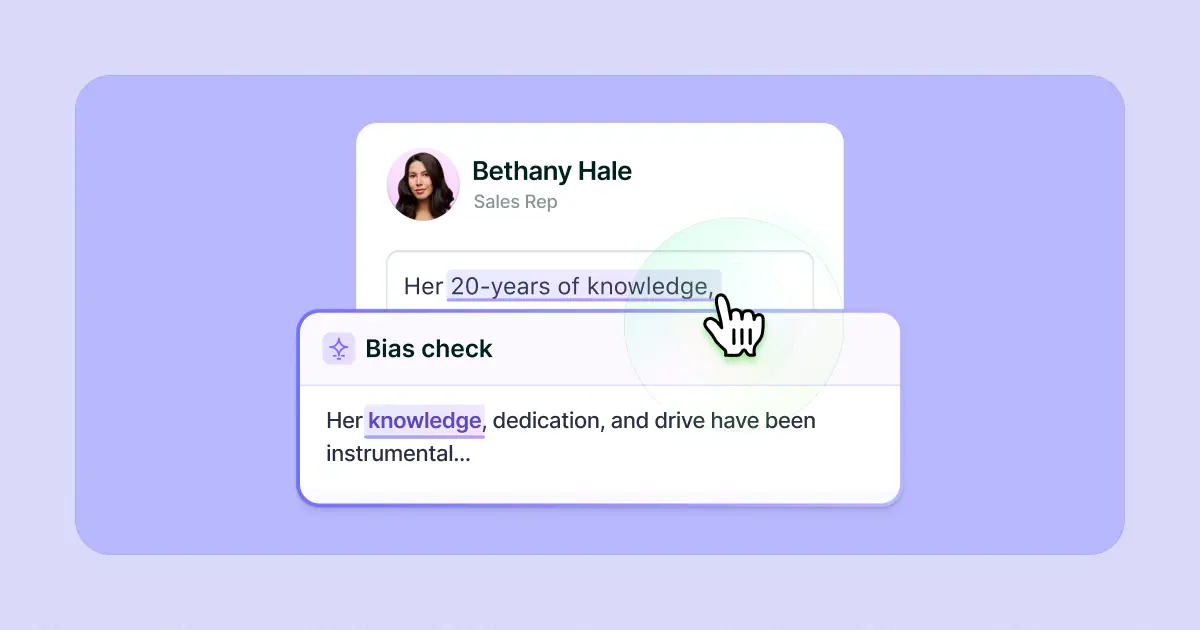If being a manager feels harder lately, you're not imagining it. Supporting remote and hybrid teams, meeting rising performance expectations, and keeping up with advances in artificial intelligence (AI) have made the role more complex than ever — especially at a time when many teams are shrinking and resources are limited.
Fortunately, AI is arriving at just the right moment. While AI could never replace the human side of leadership, it can support it. From summarizing feedback to crafting development goals and surfacing actionable insights, AI enables you to lead more strategically and focus on the moments that matter.
In this article, we’ll explore how AI is shaping modern management, share real-world applications, and offer practical ways to use your newfound understanding of AI to become the kind of manager your team needs.
{{rich-takeaway}}
The Rise of AI in Modern Management
AI technologies are rapidly transforming how businesses operate — and management is no exception. Leaders are now expected to not only guide teams through uncertainty, but also adapt to a wave of AI-driven change that’s reshaping business strategy from the ground up.
From natural language processing (NLP) and large language models (LLMs) to other forms of machine learning, AI is powering new tools that can help managers lead more effectively. It’s being built into everything from scheduling tools and project planning platforms to employee engagement surveys and performance management systems. And chances are, your company is launching its own AI initiatives and AI projects to solve business challenges and boost internal efficiency. The result? Managers can make faster, smarter decisions and spend less time buried in administrative tasks.
You can’t lead from someone else’s playbook. AI is most useful when it helps leaders build the foundational principles, then adapt them to their own style.
When used ethically and intentionally, AI becomes more than just a productivity tool — it becomes a strategic partner. And for today’s thinly-stretched managers, that partnership can be the key to building connected teams and becoming stronger business leaders.
5 Ways You Can Use AI to Be a Better Manager
Now, let’s talk about practical applications. Here are five ways you can leverage AI to help optimize your productivity, make data-driven decisions, and improve your efficiency as a manager.
1. Preparing for One-on-One Meetings
Too often, one-on-ones turn into status updates instead of meaningful, people-focused conversations. Managers show up trying to remember past feedback, goal progress, or that new project idea someone mentioned two weeks ago. But these meetings are short, so you need to be intentional about how you spend them to walk away with real value.
That’s where AI can help. It can take the pressure off by scheduling your meetings, generating conversation prompts, and translating summaries of your interactions, saving you time and keeping your meetings focused and actionable.
Lattice AI goes a step further, giving you all the context you need to lead an effective one-on-one meeting. Lattice AI can:
- Pull in an individual’s recent feedback or goal progress so you can talk about what’s actually happening, not just what you remember
- Highlight key trends or patterns, like declining sentiment or missed milestones, that signal a coaching opportunity
- Make follow-up easier with suggestions like “Add to growth plan” or “Revisit in next one-on-one”
- Set recurring reminders and prompts to prepare for upcoming one-on-ones or performance check-ins
While AI won’t run the conversation for you, it empowers you to show up prepared, lead with intention, and create more personalized, impactful experiences for your team.
2. Coaching Employees
According to Gallup research, organizations that invest in employee development report 11% greater profitability and are twice as likely to retain their employees. But while leading a team is one thing, coaching that team to grow is another skill entirely, and it’s one many managers need support with.
“Coaching is a skill that must be learned and practiced. AI can be a powerful partner in that process, especially when it’s grounded in research-backed frameworks that equip managers with the structure and guidelines needed for success,” said Tom Griffiths, CEO and cofounder of live learning platform Hone. “AI can elevate the quality of coaching by spotting patterns over time, capturing notes, analyzing feedback, and surfacing recurring themes. That kind of insight helps managers deliver more holistic, rigorous coaching, and it builds the kind of culture that raises the bar for everyone.”
Here are a few other ways AI can help you become more intentional in guiding your direct reports toward their career goals:
- Analyzing performance, engagement, and feedback data to identify coaching opportunities
- Highlighting patterns in sentiment to flag when an employee might benefit from extra support or recognition
- Summarizing updates, feedback, and one-on-one notes to spot recurring themes or areas for growth
- Suggesting tailored conversation starters and development ideas aligned to an individual’s goals, role, or performance
AI can help you deliver personalized, actionable coaching feedback instead of generic career advice, so your team feels seen, supported, and motivated to grow. And with Lattice’s AI-powered Recommended Growth Plans, creating individual development plans (IDPs) becomes even easier. With just a few clicks, you and your direct report can build an IDP based on internal career tracks, past performance reviews, and peer feedback, all in one place.
Together, you both can track plan progress over time, request additional feedback from colleagues, and keep development top of mind year-round. The result? A culture of continuous growth that supports retention, engagement, and long-term success for every employee.
3. Summarizing Survey Findings
Engagement, pulse, and manager effectiveness surveys offer valuable insights, but digging through the data to find what matters most can be time-consuming. AI can help by quickly analyzing large data sets and metrics to surface insights and recommend action plans. No need to bug your data science team! This quick analysis empowers managers to take immediate action to improve team engagement, productivity, and retention.
Lattice’s AI-powered tools go a step further:
- Team Health analyzes data from surveys, one-on-ones, and Lattice’s weekly updates feature to offer personalized recommendations that boost team participation and reduce attrition.
- Manager Effectiveness highlights performance patterns, guides career conversations, and identifies flight risks before issues arise.
- Engagement Insights quickly analyzes survey results, surfaces key engagement drivers, summarizes comment themes, and recommends targeted actions immediately following a survey.
With AI-powered tools like Lattice, you can spend less time combing through spreadsheets and more time taking action that drives meaningful change for your team.
4. Writing Performance Reviews
Giving meaningful feedback is challenging, but important. Poor or vague feedback doesn’t just miss the mark; it can drive employees away. In fact, employees who receive low-quality feedback are 63% more likely to leave than everyone else, according to a 2023 report by Textio.
In order to be effective, feedback needs to be specific, actionable, unbiased, and clear, which requires time, intention, and thoughtful writing. But when managing multiple people (and juggling everything else on your plate), it’s easy to accidentally use rushed, vague, or recycled language. And when feedback misses the mark, it can do more harm than good, like slowing down growth or straining relationships.
AI can take some of the pressure off by helping you find the right words faster, without sacrificing thoughtfulness. For example, a manager could ask ChatGPT to help them write effective performance review feedback for Emily, a product marketing manager on their team.
Why This Works:
Though they deliver the same message, the AI-assisted feedback is more effective because it follows the Situation-Behavior-Impact (SBI)™ framework:
- Situation: It specifies when the situation occurred (during the last few product launches).
- Behavior: It describes what Emily did (she failed to communicate clearly with her colleagues).
- Impact: It explains the consequences of her actions (delays or missed expectations across teams).
Finally, the AI-assisted feedback defines the way forward by offering clear, actionable steps for improvement, like sharing regular written updates and holding brief syncs with key stakeholders. This structure makes the feedback concrete, balanced, and actionable, giving Emily clarity on what happened, why it mattered, and how she can improve.
While tools like ChatGPT are only as good as the context you share with them, Lattice’s AI tools can pull in insights from past feedback, current goal progress, growth areas, and prior reviews to help you write more holistic, personalized reviews faster. In fact, Lattice’s Performance Insights tool was created specifically to help managers write better employee performance reviews in less time. It ensures your reviews capture the full picture of your reports’ performance, not just recent wins or challenges.
5. Automating Tasks
One of the biggest ways AI can help you as a busy manager is by automating manual tasks and saving you time. “From crafting plans to writing communications, AI can handle the time-consuming tasks that eat up a manager’s day. Offloading these tasks isn’t just helpful — it’s necessary when managers are more stretched than ever,” said Griffiths.
By automating administrative tasks, AI gives you more time to focus on leadership, coaching, and connection — the things that can’t be automated. AI can streamline your day by:
- Writing and polishing emails
- Taking and summarizing meeting notes and sharing action items
- Drafting project briefs and plans
- Generating agenda templates for recurring meetings
- Helping with decision-making
- Creating personalized recognition messages
- Organizing to-dos or follow-ups from Slack, email, or other project management tools
- Brainstorming solutions to data management or other business problems
- Drafting job descriptions or interview questions
- And more!
To help you integrate these efficiencies effortlessly, Lattice offers AI-powered tools that fit naturally into your daily workflows:
- AI Agent helps you spend less time answering FAQs. Employees can ask a chatbot about company policies, career growth opportunities, and people strategy to get instant answers from Lattice’s exhaustive HR content library.
- Agent Platform goes further, letting you deploy prebuilt AI agents (in areas like interviewing, onboarding, and more) or build custom ones tailored specifically to your team, department, or workflows. These agents can pull insights, answer questions, and provide real-time support.
No matter which AI solution you choose, the outcome should be the same: less time spent on busywork, more time to lead with impact.
{{rich-highlight-2}}
AI for Managers: Common Pitfalls and How to Avoid Them
If you’ve experimented with AI tools, you already know: They’re helpful, but far from perfect. AI still needs thoughtful oversight to ensure it’s accurate, fair, and aligned with your values — and it should never replace human judgment.
Used well, AI can make you a better, more effective manager, but tread carefully and avoid these common pitfalls when devising your AI strategy:
- Relying too heavily on automation: AI can be a powerful partner for problem-solving and unlocking helpful insights, but it doesn’t understand your team like you do. Use your judgment and additional context to review AI outputs before sharing them with your team or taking action.
- Allowing bias in AI-generated content: AI and deep learning algorithms can produce biased outcomes if they’re trained on skewed data, potentially leading to unfair or unbalanced feedback, performance evaluations, or recommendations. Use tools designed with equity in mind, and always review AI-generated language for fairness and inclusivity.
- Using AI-generated language without adjusting tone: Feedback and reviews should still sound like you. Tweak AI-generated drafts to reflect your communication style and your relationship with the employee, so your feedback comes off as sincere and genuine.
- Sharing sensitive data in nonsecure environments: To ensure responsible AI use, be mindful of what you share with AI tools. Unless you’re using secure, enterprise-grade platforms (like Lattice), avoid sharing any sensitive or confidential information, like salary details, performance reviews, medical history, or disciplinary records. Always check your organization’s AI use policies before using external tools to stay compliant and protect employee privacy.
- Using ineffective prompts: AI is only as useful as the prompts you give it. Clear, thoughtful input (and a little trial and error) go a long way toward getting you relevant results.
- Overlooking the human side of management: AI can’t build trust or psychological safety — that still requires genuine human connection, consistency, and care. While AI can act as a helpful advisor or tool to drive efficiency, it’s up to you to lead with empathy and intention.
“Authenticity is a fundamental pillar of effective leadership, and it doesn’t come from copying prompts or following generic AI advice,” Griffiths noted. “You can’t lead from someone else’s playbook. AI is most useful when it helps leaders build the foundational principles, then adapt them to their own style.”
Great leadership isn’t automated, it’s human. At the end of the day, it’s your presence that earns trust, drives impact, and makes a difference.
Getting Started With AI for Business and Management
Welcome to the era of AI-powered management. If you’re ready to start experimenting with generative AI (GenAI) and machine learning tools, here are a few sample prompts to help you begin. Using AI effectively is an ongoing, hands-on process, so keep prompt engineering to refine your queries, teaching the tools your preferences, and sharpening your requests to get the most value from them.
AI Prompt Examples Managers Can Try
Here are a few different use cases and applications of AI you can play around with:
- Feedback: “I’ve collected feedback about [employee name] from multiple sources over the past quarter, including peer feedback, project reviews, and one-on-one notes. Here’s the raw input [paste notes]. Can you help me summarize the key themes in their performance, including what they’ve done well, where they can improve, and any noticeable patterns or growth areas?”
- Performance reviews: “Help me write performance review feedback for [employee name], a [job title]. Include strengths, areas for improvement, and suggestions for development. They excel at [strengths or accomplishments], but could improve in [specific area]. Use a professional and supportive tone, and make the feedback specific, actionable, and appropriate for a formal review.”
- One-on-one preparation: “I’m a people manager looking to build stronger relationships with my team. Can you suggest a variety of conversation starters I can use at the beginning of my weekly one-on-ones to spark meaningful dialogue? I’m especially interested in prompts that touch on performance, motivation, wellbeing, feedback, career growth, and personal connection.”
- Engagement: “I’ve collected open-ended feedback from employee surveys. Can you summarize the key themes from this list of responses [paste anonymized feedback]? Highlight sentiment, trends, and any red flags.”
- Career growth: “I want to help my team members think more intentionally about their careers. Can you suggest questions or a discussion framework I can use in our next one-on-one to talk about long-term career goals and growth opportunities?”
How Lattice Helps Managers
Ready to learn what AI can do for your team? Lattice AI is built to help managers lead with confidence. Our many AI tools save you time, drive employee performance, and unlock team insights. Whether you’re already experimenting with AI or looking to level up specific management functions, Lattice supports you ethically, equitably, and effectively — every step of the way. From engagement and performance to development and team health, Lattice AI helps turn good managers into great ones. Take a tour of Lattice AI and discover what’s possible.
{{rich-highlight-3}}
Key Takeaways
- AI can enhance management by reducing administrative burdens and surfacing insights, allowing leaders to focus on coaching, development, and team connection.
- Practical applications include preparing for one-on-ones, coaching employees, summarizing surveys, writing performance reviews, and automating routine tasks.
- While AI boosts efficiency, managers must avoid pitfalls like over-reliance, biased outputs, insecure data sharing, and losing the human touch in leadership.
- Used ethically and intentionally, AI becomes a strategic partner that empowers managers to lead with greater impact, personalization, and authenticity.


.webp)







